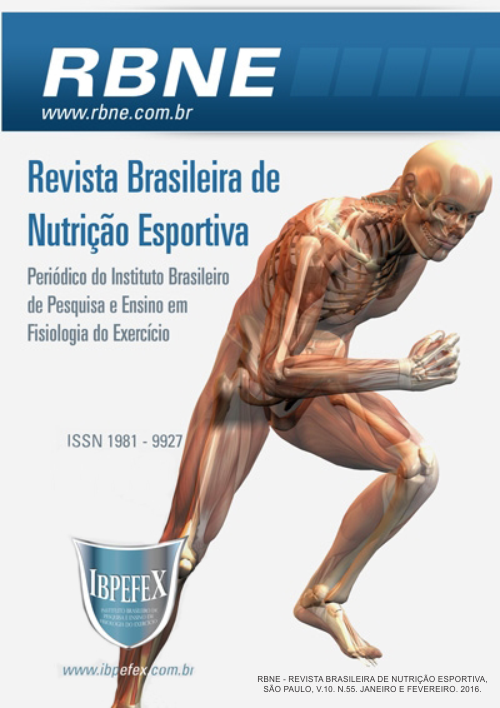Uses of equations and methods to estimate the basal energetic cost and the total energetic cost of adults that practice physical activities: a case study
Abstract
Introduction and Aims: The BEC (Basal Energy Cost / GEB) is the energy used by every cell in the human body for the maintenance of its operation. The Energy Expenditure with Physical Activities (GAF),added to the GEB and determine the GET. To estimate the GET physically active individuals is necessary to know the type of exercise performed,the frequency of training, duration and intensity. This study aimed to evaluate the different equations to estimate the GET, compare the results and point out the possible differences. Methods: A study carried out in two stages, the first part consists ofa literature review and the second evaluated the GET two adult volunteers (one male and one female) regularly physically active. Results: We found in the literature five equations that estimate the GEB, WHO (1985), FAO / WHO / UNU (1985), Schofield (1985), Mifflin-St Jeor (1990) and Harris Benedict (1919), from these equations the calculations of GEB, GET and GAF for each volunteer were performed. Discussion: When selecting an equation to estimate the GEB and GET gender, the variables (weight, height and age), factor activity and METs are important requirements to determine the energy requirement. All equations had higher estimates for males. The method of Harris-Benedit gave an estimation of the GEB, GET and REE + MET larger than the other methods. Conclusion: It was found that there were no relevant differences between the equations, so all are suitable for use.
References
-Ainsworth, B. E.; e colaboradores. Compendium of Physical Activities: a second update of codes and MET values. Medicine and Science in Sports and Exercise. Vol. 43. Núm. 8. p. 1575-1581. 2011.
-Bauce, G.; e colaboradores. Estimación del requerimiento energético para jóvenes que realizan actividad física. RFM. Caracas. Vol. 32. Núm. 1. 2009.
-Cabral, C.A.C.; e colaboradores. Diagnóstico do estado nutricional dos atletas da Equipe Olímpica Permanente de Levantamento de Peso do Comitê Olímpico Brasileiro-COB. Rev. Bras. Med. Esporte. Niterói. Vol. 12. Núm. 6. 2006.
-Carvalho, F. G.; e colaboradores. Métodos de avaliação de necessidades nutricionais e consumo de energia em humanos. Rev. Simbio-Logias.São Paulo. Vol. 5. Núm. 7. 2012.
-Galisa, M.S.; Guimarães, A. F. Cálculos Nutricionais, conceitos eaplicações práticas. São Paulo. M. Books, 2008.
-Oliveira, F. C. E.; e colaboradores. Gasto energético de adultos brasileños saludables: una comparación de métodos. Nutr. Hosp. Madri. Vol. 23. Núm. 6. 2008.
-Reis, V.M. Gasto energético, custo energético aeróbio e custo energético anaeróbio. Rev. Bras. cineantropom. Desempenho hum. (Online), Florianópolis. Vol. 13. Núm. 6. 2011.
-Rossi, L. Nutrição em academias: do fitness ao pellness. Rocca. p. 153-182. São Paulo. 2013.
-Tormen, C.C.D.; e colaboradores. Avaliação da ingestão alimentar, perfil antropométrico e conhecimento nutricional de corredores de rua de Porto Alegre. Rev. Bras. Nutrição Esportiva. São Paulo. Vol. 6. Núm. 31. 2012.
-Viebig,R.F.; Nacif, M.A. L.;Silva, S.M.C.; Mura, J.D’arc P. Tratado de alimentação, nutrição e dietoterapia. Rocca. p. 246. 2011.
-Viviani, M. T.; e colaboradores. Correlação entre o gasto energético, peso corporal e massa magra de mulheres sedentárias e ativas. Colloquium Vitae. São Paulo. Vol. 1. Núm. 2. p. 75-83. 2009.
-Volp, A. C. P.; e colaboradores. Energy expenditure: components and evaluation methods. Nutr Hosp. Vol. 26. Núm. 3. p. 430-440. 2011.
Authors who publish in this journal agree to the following terms:
- Authors retain the copyright and grant the journal the right of first publication, with work simultaneously licensed under the Creative Commons Attribution License BY-NC which allows the sharing of the work with acknowledgment of the authorship of the work and initial publication in this journal.
- Authors are authorized to enter into additional contracts separately for non-exclusive distribution of the version of the work published in this journal (eg, publishing in institutional repository or book chapter), with acknowledgment of authorship and initial publication in this journal.
- Authors are allowed and encouraged to post and distribute their work online (eg, in institutional repositories or on their personal page) at any point before or during the editorial process, as this can bring about productive change as well as increase impact and impact. citation of published work (See The Effect of Free Access).






